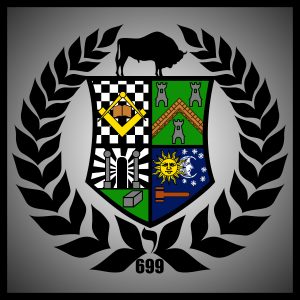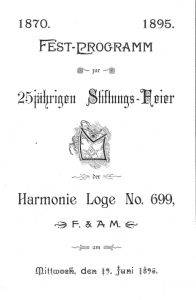Genesis
The history of Harmonie Lodge is closely tied to the growth and transformation of our home, the City and region of Buffalo, New York. Beginning as a trading post at the western edge of New York State, the 1825 opening of the Erie Canal (brainchild of M∴ W∴ DeWitt Clinton), spurred fast growth. Men and women from across the country – and all over the world – came to Buffalo to live and work. The City of Buffalo especially attracted German immigrants, who, by the 1840s, made up one-third of the city’s population (the largest foreign-born group in Buffalo).
In 1848, the Grand Lodge of Free & Accepted Masons of the State of New York granted a dispensation to form the first German-American Lodge in Buffalo, known as Concordia Lodge No. 143. Concordia Lodge’s Charter was granted June 13, 1849. In July 1854, a Charter was granted to the second German-American Lodge in Buffalo, Modestia Lodge No. 340.
In spite of the tribulations suffered by much of the nation during the American Civil War, the City of Buffalo grew and expanded during the 1860s. Abraham Lincoln visited Buffalo on February 16, 1861, and the Civil War years saw an increase in the population of Buffalo from 81,029 to 94,210 by 1865. In 1868, construction on Frederick Law Olmsted’s public park system began in the City, creating the United States’ oldest coordinated system of recreational spaces and parkways. During this time of local prosperity, 17 Brothers from Modestia and Concordia Lodges decided to form a third German Lodge in Buffalo. Dispensation was granted by the Grand Lodge on November 30, 1869, to form our Lodge, Harmonie No. 699, which was named after the Greek Goddess of Harmony – (Harmonia).
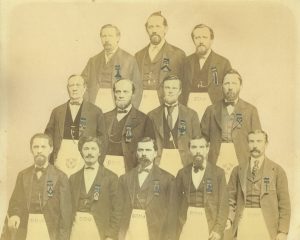
The first meeting under dispensation, on December 15, 1869, was held over Charles’ Ladies Apparel Store at 416 Main Street, just south of Court Street, in Buffalo. This building later became C. A. Weed & Co.’s place of business, and eventually Liberty National Bank, and is known today as the Liberty Building. The first candidates initiated into Freemasonry at Harmonie Lodge on January 15, 1870, were Bernhardt F. Gentch, William Jaeger, Wemer Nachbar, and Henry D. Zittel. The Charter for Harmonie Lodge was finally granted on June 13, 1870.
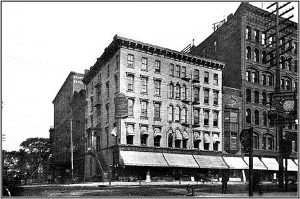
By the 1880s the City of Buffalo and her Masons were both thriving. In 1888, elaborate plans were made for the financing and erection of the Masonic Temple at 43 Niagara Street. The building contract was awarded for the sum of $130,541 for labor and materials, except the cost of the brick, which was furnished by Brother Louis Kirkland of Concordia Lodge No. 143. Harmonie Lodge owned an equal share of the Temple property with other Lodges on account of our significant contribution to its financing.

Harmonie Lodge was well known for its Octet singing at the beginning of the 20th century. Vocal music being quite popular at that time, some members of Harmonie Lodge also belonged to “Buffalo Orpheus”, which was a famous German singing society, and which featured a splendid rendition of “Gott Gruese Dich”. Brother Fritz Erfling was the organist, director, and choirmaster of Buffalo Orpheus for many years.
On June 19, 1895, Harmonie Lodge celebrated its 25th anniversary (25. Jahrestag Feier). The keynote address at this event was given by Most Worshipful Christopher G. Fox, Grand Master of Masons in the State of New York.
Metamorphosis
The brethren of Harmonie Lodge utilized the German language – in both business and ritual – until the year 1914. This alteration (from traditional German to English) opened the Lodge’s doors to many non-German speaking sons, relatives, and friends, affording them an opportunity to ask for Masonic membership petitions, and increasing our Lodge membership to nearly 475 Masons.
The 50-year Golden Jubilee of Harmonie Lodge was celebrated in 1920, beginning on Sunday, June 13th. Worshipful Master Frederick Woelfinger, officers and members, first attended services at St. Paul’s United Evangelical Church. The address and sermon were given by Rev. Christian G. Haas, who was also the Chaplain of our Lodge. Reflecting over the past years, he stated, “Good has been our past, as were the material and spiritual accomplishments. We also know we have not attained perfection in our daily life. There is always work waiting for our Brethren, for a continued desire to be faithful to mankind.” On June 14th, Brothers and their wives attended dinner, entertainment, and dancing at the Ellicott Club. Many notable Masonic dignitaries of various Lodges and concordant bodies were invited, and they expressed their charitable views of Harmonie Lodge’s first 50 years of Masonry.
The 75-year Diamond Jubilee celebration began a few months after the close of World War II, on October 17, 1945. Worshipful Master John W. Williams, officers and brethren, attended services at Trinity Evangelical Church of Christ. The address and sermon were again given by our then-Lodge Chaplain, Rev. Leon K. Molter. He outlined the high ideals of our Lodge during the past 75 years, evaluating our blessings, and humbly asking that our Symbolic working tools always be kept bright and shining, for a continuity of service to our beloved Craft. On October 20th at 8:00 PM, a regular stated communication for members and Masonic friends was held, wherein W∴ John W. Williams and the officers presented an ideal 75th anniversary program. A few weeks later, on November 10, 1945 at 6:30 PM, a dinner, entertainment and dancing for Lodge members, their family and friends, was held at the Buffalo Trap and Field Club, to conclude the Diamond Jubilee celebration.
After the close of World War II, like many American fraternities, Harmonie Lodge continued to grow in membership and fellowship. In fact, brethren of Harmonie Lodge played prominent parts in the founding of other Lodges, including Eggertsville Lodge No. 1157 and Cheektowaga Lodge No. 1163. In particular, R:. W:. George A. Richter with the aid of V∴W∴ Harry Saxton formed a square club that eventually become Eggertsville Lodge. By July 1957, the Sweet Home Square Club was operating and many of Harmonie’s members were participating therein. Seven of the charter members of Eggertsville Lodge were members of Harmonie No. 699 (Rowland Williams, Harry Saxton, Robert Cochrane, Theodore Shamp, Frank Hendry, James Thompson, Richard Harris and George Richter – honorary). W∴ Rowland Williams, Master of Harmonie Lodge in 1949, became Eggertsville Lodge’s first Master. When dispensation was granted, R∴W∴ Henry Z. Lang, Jr. sat as Master for the evening prior to the officers taking their stations under dispensation. R∴W∴ Harry Saxton became Eggertsville Lodge’s second Master. On the occasion of the granting of the Charter to Eggertsville Lodge, the Fellowcraft Club of Harmonie Lodge presented a complete set of officers’ aprons to the new officers of Eggertsville Lodge.
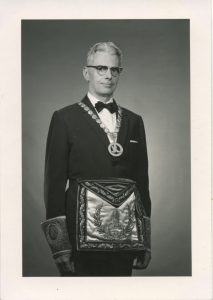
Similarly, Assistant Grand Lecturer, V∴ W∴ Harry E. Saxton and R∴ W∴ George A. Richter became charter members of Cheektowaga Lodge No. 1163, and W∴ Medford E. Hampe became Worshipful Master of that Lodge in its early years.
On the occasion of our 100th Anniversary, Harmonie Lodge was granted the special privilege by the officers of Liberty Bank, to hold our Anniversary Lodge meeting on December 3, 1969, at the site of our first meeting; the aforementioned Liberty Building in downtown Buffalo. At this meeting, Charles W. Weiftheimer was elected Worshipful Master, together with the officers for 1970. In keeping with the tradition of marking important Lodge anniversaries, a Gala Banquet at the Ismailia Shrine Mosque was held to celebrate our Centennial. We were honored by an address by Most Worshipful Grand Master William R. Knapp. Worshipful Donald R. Coe, introduced many Masonic notables while warmly serving as Toastmaster.
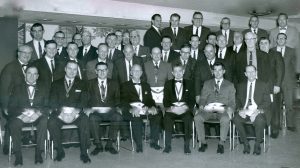
Despite the auspicious history and development of Harmonie Lodge, we were spared not the demographic and social challenges experienced by Lodges in the latter part of the 20th Century. Because of the changing community and the reconstruction of our inner city, the architectural splendor that was our Masonic Temple was razed in 1971. Today, it is the site of the New York State Family Court building of Erie County. When it became necessary to vacate the Temple property, the equity of each owning body was prorated and then paid to each owning body of the Temple. The amount that Harmonie Lodge received became, for many years, the Lodge’s permanent fund, or nest egg. After the closing of the Buffalo Temple, Harmonie Lodge rented lodge room space from Ancient Landmark Temple at 318 Pearl Street for two years, and, in 1973, took up Lodge room rental of Depew Masonic Temple. In September 1994 a move was again made, to our current (and semi-permanent) home at Although far from immune to the demographic challenges facing the Craft (the loss of older Brothers with fewer new initiates seeking to take their place) Harmonie survived these “lean” years through the wizened leadership of men like W∴ Alois Altendorfer, R∴W∴ Henry Sip Lange, Jr., W∴ Richard N. Koenig, W∴ Karl H. Buehrig, W∴ Robert H. Bickert, W∴ Kenneth E. Bigelow, W∴ Jeffrey L. Parks, W∴ Leroy H. Lieder, V∴W∴ Ronald J. Keel, W:. Gerard E. Schultz, Jr., R∴W∴ James M. Kipler, W∴ Dan Gajewski, R∴W∴ John L. Leszak, and others.
Renaissance
The beginning of the 3rd Millennium has seen a worldwide resurgence of interest in Freemasonry. Much of this can be attributed to popular culture’s recent fascination with our Craft. Books such as Dan Brown’s DaVinci Code and Lost Symbol; high profile articles in U.S. News & World Report, the New York Times, and CBS Sunday Morning; movies such as National Treasure; History Channel documentaries; an explosion of Masonic websites; and even the Simpson’s Stone Cutters parody, have fueled this increased interest.
Harmonie Lodge has benefited greatly from this popular exposure and has leveraged the internet and social media platforms to attract and retain new members. These new Brothers are sometimes the grandchildren of Masons and the children of the “lost generation” of men who avoided the traditions of their fathers. Thus, in some ways, we have brought back into the fold many family lines nearly lost to Masonry.
As the 21st century progressed, we saw an explosion of worthy and well-qualified young men petitioning Harmonie Lodge. These enthusiastic new brethren have been drawn from a diverse set of professional backgrounds including law, medicine, business, banking, government, and information technology.
On December 31, 2005, Harmonie Lodge lost one of her most dedicated Brothers and a consummate ritualist, V∴ W∴ Ronald J. Keel. The brethren of Harmonie Lodge were deeply affected by his untimely passing, and on January 11, 2006, we established the Ronald J. Keel Fellowcraft Club to honor his memory. The Ronald J. Keel (RJK) Fellowcraft Club affords new Lodge members the opportunity to learn, socialize and work together in a relaxed, casual atmosphere. The Club is dedicated to charity, education, and fellowship. The founders of the RJK Fellowcraft Club were J.C. Litwin, Bro. John P. Balk, and W∴ Frederick G. Clark II. As an organ of Harmonie Lodge, the Club continues to grow and has attracted members from Lodges across Erie County. As much as it is a platform for growth for all Fellowcrafts, it is also a proving ground for Lodge leadership, by thoroughly cultivating the potential of each of its members. The R.J.KF.C also founded the Ward A. Peterson Fund. This started as a simple assistance fund, nothing but a few hundred dollars just in case a Brother should need help. As the recession grew in 2008 the fund quickly depleted . V∴W∴ Daniel J. Di Natale, President of the R.J.K.F.C 2011-13, reestablished the fund and it quickly grew. It has grown so large so fast that it is now part of the Lodge’s permanent budget and under Trustee control. The Ward A. Peterson Fund ,since 2011, has raised and donated well over $10,000 to many charitable causes. The most important being direct relief of a Brother or his family in times of need.
In September 2006, Harmonie joined with Masons across New York in celebrating the 225th Anniversary of the founding of the Grand Lodge of Free & Accepted Masons of the State of New York. Harmonie’s Master R∴ W∴James Kipler presided over the Lodge rededication ceremony, in which the brethren renewed their obligations to the Craft. In 2007, during the Mastership of W∴ Gerard E. Schultz, the Brethren of Harmonie Lodge performed the Master Mason Degree in its entirety for the first time in recent memory. W∴ Schultz’s Mastership was marked by a an increase in the membership, and a growth of educational programs and ritual proficiency.
Inspired by the example of V∴ W∴ Bro. Keel, and supported by Lodge statesmen like W∴ Gerard E. Schultz, Jr., W∴ James M. Kipler, and R∴ W∴ John L. Leszak, between 2005 and 2008, the seeds of significant renewal in Harmonie Lodge were planted and began to germinate. Working groups of young Brothers sprang up to explore the variety of Freemasonry existent in the United States and abroad, such as European Concept Lodges and Traditional Observance Lodges. Brothers Shoff , Clark, and Di Natale along with J. C. Litwin, were impressed with the return to classical, Enlightenment, traditions displayed in these Masonic styles, but did not wish to limit the brethren of Harmonie Lodge to a style or concept developed and defined by others. Harmonie Lodge has always been unique, and these Brothers sought to renew Harmonie Lodge in a like distinct fashion. Combining some of the formalities and methods of early Masonic Lodges with new technologies and cutting-edge ideas, Janusian Masonry was born at Harmonie Lodge.
It is hard to believe that it has been only a little more than six years since these reforms began to be implemented, as the brethren raised in Harmonie this year are undertaking such a uniquely different experience than the new members and Brothers of the early 2000s.
On June 11, 2008, Jonathan C. Litwin was installed as the first Master of Harmonie Lodge to have been raised in the 21st Century. J.C. Litwin served as Master of the Lodge until June 2010. While we must rightly recognize the initial contribution that Litwin made to the concept of Janusian Masonry, it is important to note that, sadly, he was subsequently expelled from the Fraternity in 2013 after being found to have committed significant acts of un-Masonic conduct. Nevertheless, the spirit of Janusian Masonry survived, and thrived, during the Masterships of W∴ Nathan A. Shoff, W∴ Frederick G. Clark, III, and V∴W∴ Daniel J. DiNatale – the Founders of Janusian Masonry.
From 2008 through 2013, the Lodge Bylaws (the organizing rules of the Lodge) were significantly updated and revised to account for modern methods of communication, and streamlined processes, such as the use of electronic correspondence for notification of special Lodge meetings. Although our financial investments have always been prudently managed by the elected Trustees and their agents, our Lodge did not escape the financial collapse which marked the beginning of the Great Recession in 2008. Compounding the loss of a large percentage of our investment portfolio, was the fact that, for many years, Harmonie ran on deficit spending (withdrawing funds from our investments to cover regular annual lodge costs). W∴ Shoff and W∴ Clark put a stop to this by returning the members’ dues structure to a level that was both reasonable in relation to the value provided by Lodge membership, and sufficient to fully cover the Lodge’s projected financial needs. In 2012 the Lodge finalized a structured wealth management plan, placing us on sure footing for the foreseeable future. This first Janusian act – to financially shore up the Lodge and recognize its true value to members – was accomplished by enacting a bylaw which gradually increases regular members’ dues through the year 2020.
One of the hallmarks of Janusian Masonry as it has developed during the Masterships of Brothers Shoff, Clark and Di Natale, include a renewal and elaboration of our Masonic Ritual – one of the core functions of a Freemason’s Lodge. For example, during W.: Shoff’s time as Master of the Lodge, the brethren superbly performed all portions of the Three Degrees’ rituals, and many of said rituals were accompanied by beautiful music. While it was the tradition for many years that a Masonic Lodge have a trained keyboard player to accompany the ritual with organ or piano, most lodges (Harmonie included) no longer have brothers skilled in that particular instrument. However, with the advent of inexpensive laptop computers and digital music, our Lodge has been able to include some of the most beautiful full choral and orchestral music during our ritual performances, with the click of a button. W∴ Clark and W∴ DiNatale built on W.: Shoff’s foundation, by commissioning and building a first-rate surround-sound speaker system in the lodge room at Sweet Home Masonic Temple.
V∴ W∴ DiNatale has been a vocal critic of poor ritual, and a keen student of the development of Masonic ritual text from the pre-Anderson days of the Craft, through to our “modern” Ritual Renaissance. For his efforts, he was most recently honored by the Grand Lodge of New York by being appointed the Assistant Grand Lecturer for the First Erie District. Specific to Harmonie Lodge, V∴ W∴ Di Natale helped to raise funds for – and secure – new lodge officer jewels and aprons, just in time for our 140th Anniversary in 2010. Additionally, during V∴W∴ DiNatale’s term as Master of Harmonie Lodge, he obtained brand new candidate and participant clothing for the Third Degree of Masonry in 2013. While remaining true to our traditional ritual text, the improved performance, music, and accoutrements made possible by modern technology, have served to increase the depth of meaning imparted thereby.
Another key component of the Janusian-style rebirth in Harmonie, has been our renewed focus on Masonic education and scholarship. In 2009, the officers of Harmonie Lodge formalized and named the Masonic educational programs that had been developing ad hoc since 2004. The Lodge named this system of Masonic education “Concordia Collegium: Academy of the Progressive Science of Freemasonry.” Four courses of study were made available: (1) Candidates Course (prospective Brother through Master Mason); (2) Officers Course (Junior Steward though Junior Deacon); Masters Course (Senior Deacon through Worshipful Master); and Continuing Masonic Education (Master Mason through Past Master). A primary feature of the Candidates’ Course, includes the creation of a “Master’s Piece” by a Fellowcraft aspiring to become Master Mason. Just as the operative Fellowcrafts of old had to prove their worth through the beautiful carving of stone, our speculative brethren have created magnificent works of music, art, science, woodcraft, scholarly research, poetry, and prose. This has not only enriched the candidates’ experience, but also the Lodge as a whole.
More than twenty-eight lectures, seminars, and other educational programs were presented by the brethren of Harmonie Lodge from 2008 to 2014, with many of the presentations having been published on our website. These programs included topics on Masonic Law, Masonic History, the symbolism and meaning of Tracing Boards, historical development of Masonic ritual, Freemasonry and ancient mystery schools, and even Freemasonry viewed through the lens of pop culture. The quality and extent of these programs led to several invitations to lecture at the Western New York Lodge of Research and Erie County School of Instruction for Master Masons, and, in 2013, the research paper “The Ancient Landmarks: Our Indefinite Boundaries” by W:. Nathan A. Shoff was selected for inclusion in the WNY Lodge of Research’s Book of Transactions in 2013.
If that were not enough, the Ronald J. Keel Fellowcraft Club presented the Masonic University of New York’s Masonic Development Course (MDC), in three parts in January, February, and March of 2010. The faculty for the MDC were R:. W∴ James Kipler as head proctor, W∴ Nathan Shoff, W∴ Ted Clark, and V∴W∴ Daniel Di Natale. There was a large turnout from both Harmonie and the other Lodges in the Erie Districts.
Although important to the mental and moral development of our brethren, Masonic education can sometimes get a bit dry. To avoid this, W∴ Shoff developed a Masonic-themed Jeopardy game that members of Harmonie Lodge have played once annually since 2009. This event has become so popular for the fun way in which it teaches Masonic history and concepts, that it was borrowed by the First & Second Erie Districts, who, in 2012, ran the V∴ W∴ Ronald J. Keel Jeopardy Tournament, to benefit the Masonic Care Community. Harmonie’s version of Masonic Jeopardy has since been used by Lodges and Districts across the State.
In addition to the fun of Masonic Jeopardy, W.: Shoff also took interested brethren on a “field trip” across interesting and important Masonic sites in and around Buffalo. V∴ W∴ Di Natale expanded on this concept and, since 2011, has annually hosted a tour of Famous Freemasons in Forest Lawn Cemetery. This provides an opportunity for brethren and guests to learn how interwoven the Craft has been with the development of our City and region, as well as pay respects to our Masonic forebears.
Another important facet of Janusian Masonry championed by Brothers Clark and DiNatale, is the steadfast connection between Masons, the Masonic Community, and the Community at large. In a word, Fellowship. During each of the Master’s visits to Grand Lodge in New York City since 2009, the Master of Harmonie and selected brethren, have broken bread (and imbibed their share of grain) with amazing Brothers and friends from downstate lodges, such as Mariners Lodge No. 67.
In June 2011, W∴ Frederick (“Ted”) Clark II was installed as Master, and his benevolent and diplomatic leadership raised Lodge morale to an all-time high. He streamlined Lodge business meetings, reducing them to 30 minutes in length with the implementation of new administrative procedures, and providing ample time for the renewed fellowship of the Festive Board (or “Agape”). Additionally, W∴ Clark pursued increased cooperation and fellowship between Lodges in the First Erie District, including our brethren attending the Scottish Table Lodge of Ancient Landmarks Lodge, the educational seminars of the WNY Lodge of Research, and providing assistance when needed to other Lodge’s ritual degrees. Another enjoyable fellowship event started in October 2013, was the “Wine with Neal” wine tasting for Brothers and their wives/girlfriends, hosted at Bro. Kratzer’s wine store, The Wine Room in Williamsville.
The first presentation of the Harmonie Lodge Distinguished Speaker Series kicked off on October 26, 2011, when W∴ Andrew Hammer, Past Master of Alexandria-Washington Lodge No. 22, graced us with his presence. He presented a lecture based on his recent book, Observing the Craft: The Pursuit of Excellence in Masonic Labour and Observance. Observing the Craft is a manifesto of sorts for the observant Mason, who seeks quality over quantity in every aspect of Masonry. It is a stringent argument for the Symbolic (Blue) Lodge as the new plus ultra of the Craft, asking that Masons put actions behind their statements that “nothing is higher than the third degree.” It is a book that calls for nothing but the utmost personal effort and commitment to be put into the operation of a Masonic Lodge, and the experience of a Masonic meeting, in search of the transformational experience which Masons define as “making good men better.” V∴ W∴ Di Natale was honored to host the next Distinguished Speaker in 2013, W∴ Patrick Craddock (scholar and artisan behind the unique apron and regalia source The Craftsman’s Apron), who gave the presentation “Admit Him if Properly Clothed: The Evolution of the Masonic Apron in America 1740 to Present”.
A bedrock of Harmonie Lodge – as with all well-governed Freemason Lodges – is the act of providing charitable relief to brethren and society at large. Harmonie Lodge has been distinguished in exhibiting this virtue in the past 3 years. For example, with the assistance of V∴W∴ Di Natale (then-President of the RJK Fellowcraft Club), W∴ Clark was able to present a significant donation to the Masonic Medical Research Laboratory on behalf of Harmonie Lodge in 2011. After the terrible floods suffered by our downstate neighbors due to Hurricane Sandy, in 2012, V∴ W∴ DiNatale along with Bro. Jacisin, Bro. Kaminski, and Bro. Borowski brought a caravan of much-needed supplies donated by our upstate brethren, to the Brothers of New York City and New Jersey.
For all these developments, Harmonie Lodge has been greatly honored, including being awarded the Mark Twain Award for Excellence in Masonic Awareness for 2010. This prestigious award was announced at the Annual Conference of Grand Masters in late February 2011 and was presented to Harmonie Lodge by M∴ W∴ Vincent Libone, Grand Master of Masons in the State of New York in May 2011. Only 17 Lodges in North America received this honor. But the greatest honor, has been the consistent growth in membership of devoted Brothers over the past decade, and the secure future our Lodge will enjoy for many years to come.
